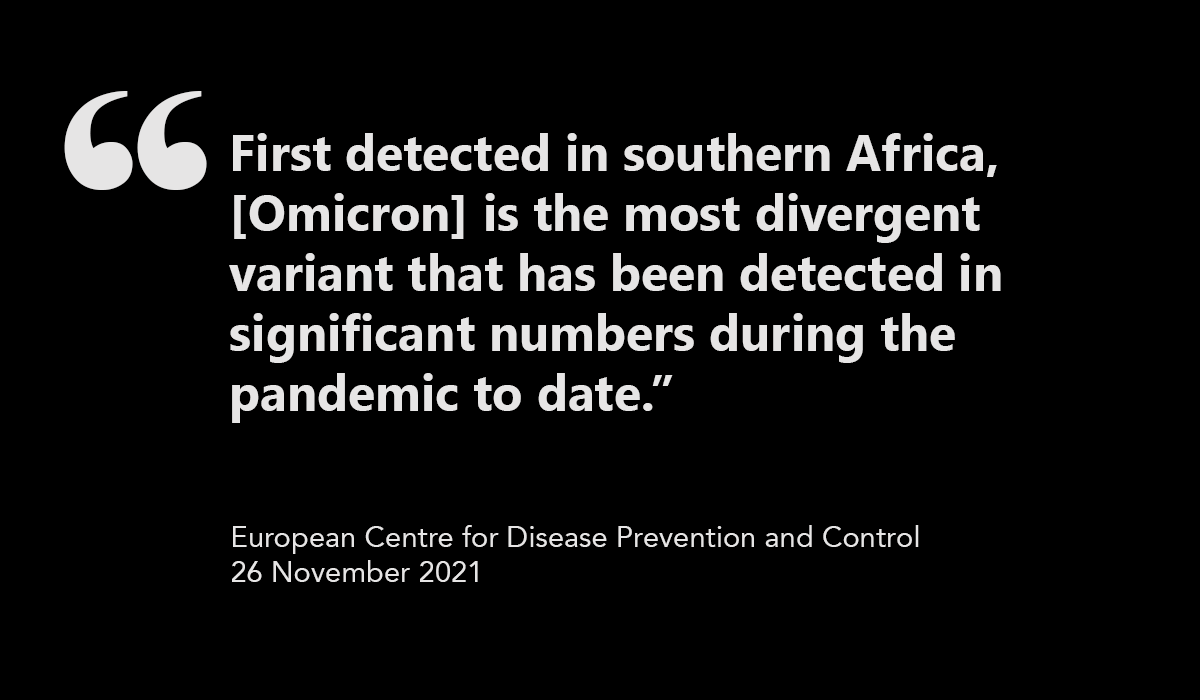26 November 2021 ⚡️What you need to know about Omicron, the latest COVID-19 variant of concern
Get vaxxed; get boosted; wear a mask; physically distance. Variant detection does necessarily mean variant point of origin.
On Thanksgiving, the health ministry in South Africa announced a new SARS-CoV-2 variant, B.1.1.529. In an emergency meeting Friday, the World Health Organization designated it as a variant of concern (reserved for variants that may spread quickly) and provided it with the label Omicron (from the Greek alphabet).
Knowing the genome sequence helps scientists identify how the virus is mutating and how it moves from person to person. South Africa and the United Kingdom were the first nations to implement nationwide genomic surveillance for SARS-CoV-2 in early 2020. In the past 180 days, Sweden and Iceland have let the world in genomic sequencing of samples (36.7% and 36%). The United States has dramatically increased the number of positive samples subject to testing (6.93%).
Dr. Andrea Ammon, director of the European Centre for Disease Prevention and Control, said that in light of Omicron that it’s important to close the immunization gap and for adults to get boosters. Due to uncertainties about infectiousness and response to antibodies, “reinforced implementation of non-pharmaceutical interventions (masks and distancing) is now more important than ever.”
The United States is implementing a travel ban in “an abundance of caution” although the virus has been detected in countries other than the list of eight African nations. The United Kingdom has also implemented a ban. South Africa has objected to these travel bans. It’s important to understand that point of detection does necessarily mean the point of origin.


When and where has Omicron been detected?
On 25 November 2021, South African scientists held a press event to announce their concerns about this new variant.
Prior to the announcement from South Africa, scientists from Botswana and Hong Kong had also uploaded the variant to a global sharing database. The earliest genomic samples were collected in Botswana on 11 November 2021 and in South Africa on 14 November 2021.
Trevor Bedford, from Fred Hutch in Seattle, was a lead scientist in identifying the initial United States outbreak. He has applied the same approach to data analysis using 77 Omicron genomes from Botswana and South Africa. Bedford estimates a common ancestor between 19 September and 21 October.


According to Nature, “Two quarantined travellers in Hong Kong who have tested positive for the variant were vaccinated with the Pfizer jab, according to news reports. One individual had travelled from South Africa; the other was infected during hotel quarantining.”
On Thursday, Israel announced it had detected one case; two additional cases are suspected. All three had traveled to Malawi, in southeastern Africa. On Friday, Belgium announced it had detected the variant from traveller returning from Egypt.

Why is Omicron a concern?
Omicron has more than 30 mutations on the spike protein; this is twice as many mutations as the Delta variant. Mutations located here are linked to “heightened infectivity and the ability to evade infection-blocking antibodies.”
South African scientists detected the variant in the Gauteng province. Positivity rates these had jumped from 1% to more than 30% in less than two weeks. Almost all the cases were linked to the new variant. South African scientists expect to soon upload 200-300 Omicron genetic sequences for global sharing.
Many of the Omicron mutations “look like they are likely contributing to further evasion,” according to Penny Moore, a virologist at the University of the Witwatersrand in Johannesburg, South Africa.
However, Michael Osterholm, who directs the University of Minnesota's Center for Infectious Disease Research and Policy, pointed out that “it’s too early to say” if this variant can evade immunity. He also reminded readers that an earlier variant of concern identified in South Africa (Beta) did not became dominant globally.
How does Omicron respond to testing?
The standard nasal swab (P.C.R.) test checks only two of the 39 SARS-CoV-2 genes, the spike gene and another called nucleocapsid. Omicron does not test positive for the spike gene.
Therefore, scientists are searching for samples that are positive for nucleocapsid and negative for spike. Spike-negative samples have been surging across South Africa. Fewer than one-quarter of the South African population is fully vaccinated.
What about existing treatments?
“Scientists expect that recently approved antiviral drugs, such as Merck’s pill, will work as effectively against the new variant because these drugs do not target the spike protein – they work by stopping the virus from replicating. However, there is a bigger risk that monocolonal antibodies, such as Regeneron’s treatment, could fail or partially fail because they target parts of the virus that will have mutated.”

Global response
In the US, Black Friday traders sent the Dow down 900 points (2.53 percent). The S&P 500 also dropped 2.27 percent, and the Nasdaq Composite, 2.23 percent. Japan’s Nikkei 225 and Hong Kong’s Hang Seng index both dropped more than 2 percent. Germany’s Dax index dropped more than 4 percent.
🤓 Recommended reading
👓 See COVID-19 resource collection at WiredPen / See all newsletters
👓 See primary news sources





